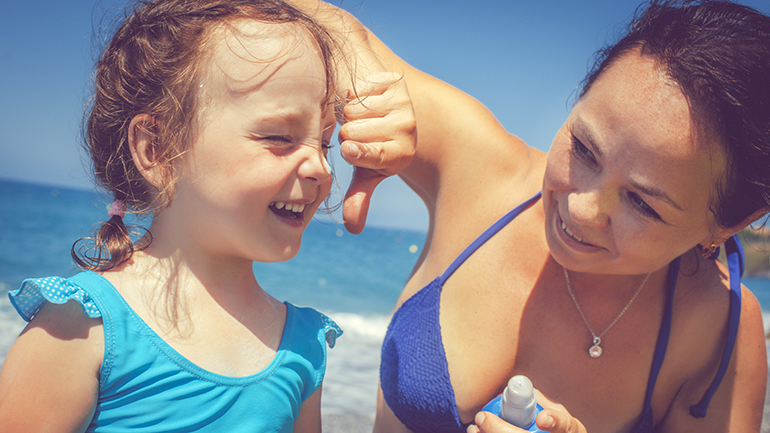
Not all sunscreens are created equal and it’s easy to get confused.
You may think that when it comes to sunscreens, you’ve got the facts – and your family – all covered.
But did you know putting on sunscreen does not actually increase the amount of time you can safely spend in the sun? Sunscreens only are meant to increase your protection when you have to be outside, not extend it indefinitely.
Now that the weather’s warming up and we’re all spending more time outdoors enjoying the sun, we need to ensure our skin is protected, and that starts with sunscreen. But not all sunscreens are created equal and it’s easy to get confused.
Here’s another common misconceptions about sunscreen: While sunscreens can help reduce sunburn, they aren’t as effective against other harmful effects of UV rays, such as premature aging and weakening of the immune system. Exposure to UV rays can cause sunburns that may eventually contribute to developing skin cancer.
Many of us also aren’t clear on what exactly the sun protection factor (SPF) listed on labels means. Let’s say you’d generally get sun damage after 10 minutes in the sun without protection. A sunscreen with an SPF of 30 can protect your skin for about five hours before you’d burn, provided you apply it properly and keep applying it according to instructions.
And most of us make the mistake of thinking that if an SPF 30 sunscreen is good, an SPF 50+ sunscreen will offer much better protection. Actually, it won’t. A sunscreen with SPF 15 already blocks 93 per cent of UVB rays, an SPF 30 blocks 97 per cent, and SPF 50+ sunscreens block 98 per cent of harmful UVB rays – a difference of just one per cent protection between the SPF 30 and 50.
Now that you’ve got the real skinny on sunscreen, here are some helpful sunscreen safety tips from Health Canada:
- Choose a high SPF. Protect your health by using a sunscreen that is labeled “broad-spectrum” to protect against most UVA and UVB rays with a Sun Protection Factor (SPF) of at least 30. Don’t forget about an SPF lip balm.
- Look for water-resistant formulas. Look for claims on the label that the product is “water-resistant.” Remember, no sunscreen is fully waterproof and should be reapplied after swimming or sweating.
- Read application instructions. For best results, follow the application instructions on the label. Put on sunscreen 30 minutes before you go outside so it soaks in.
- Use lots of sunscreen. Use the recommended amount of sunscreen. It may be more than you think – enough to turn your skin white for a while.
- Apply it often. Apply sunscreen before heading outside and use a generous amount. Reapply 20 minutes after going outside and at least every 2 hours after that. Cover exposed areas generously, including ears, nose, tops of feet and backs of knees.
- Protect yourself. Sunscreen is only one skin-protection strategy. Use a few techniques. Sunscreen and insect repellents can be used safely together. Apply the sunscreen first, then the insect repellent. Limit time you spend in direct sun outdoors during peak hours of 11 a.m. to 3 p.m. Seek shade when possible. Wear a wide-brimmed hat, sunglasses with UVA/UVB coatings, and a light layer of clothing to cover exposed skin. Plus, stay hydrated with water.
- Sunscreen and babies. Do not put sunscreen on babies less than 6 months of age. Keep them out of the sun and heat entirely as their skin and bodies are much more sensitive than an adult's.
- Test for an allergic reaction. Before using any product on you or your child check for an allergic reaction, especially if you have sensitive skin. Apply it to a small patch of skin on the inner forearm for several days in a row. If the skin turns red or otherwise reacts, change products.
For more sunscreen and safe sun tips check out our article, Soak up the sun safely and learn how to stay healthy in a heat wave.
You can also read more about protecting your skin from the sun at HealthLink BC or check out the BC Cancer Agency and the Canadian Melanoma Foundation’s Suntips.ca web site for more information.
For guidelines on choosing sunscreens, especially for young children with sensitive skin, you can visit the Canadian Dermatology Association’s list of approved sunscreens.
Go slap on some sunscreen and get outside this summer!
Find tips to help you and your family have your healthiest summer yet in our Your Healthy Summer Guide.
